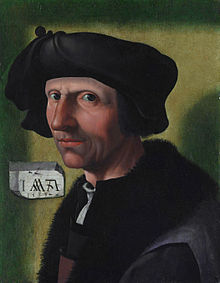Jacob Cornelisz. van Oostsanen
Jacob Cornelisz. van Oostsanen , also Jacob Cornelisz. van Amsterdam (* before 1470 presumably in Oostsanen , † 1533 presumably in Amsterdam ) was a Dutch painter and woodcut master at the end of the late Gothic period . He can be seen as one of the last representatives of traditional painting before the adoption of new style elements of the Renaissance in painting in the north of the Netherlands. Cornelisz. is the short form for Corneliszoon , which translated means son of Cornelis . The geographic origin data then added is a later epithet .
Life
From the life of Jacob Cornelisz. is little known, but is listed in a 1604 book with biographies of famous painters. Presumably he came from the small community of Oostzaan in the north of the Netherlands between Amsterdam and Zaandam. In 1505 his name can be found in the directory of the Guild of St. Luke in Amsterdam. His work includes woodcuts, such as a well-known illustration of a Passion of Christ and paintings in oils. The mentioned biography indicates that Jacob Cornelisz. enjoyed a high reputation in Amsterdam and the wider area during his lifetime. Cornelisz. received commissions to perform religious scenes, but also secular commissions such as portraits, which may indicate a change in the artist's position away from the dependence on purely ecclesiastical clients at the end of the late Middle Ages. His biography shows that many of Cornelisz's religious works were lost in the course of the reformation unrest.
The painter Dirck Jacobsz. was his son; a grandson was the painter Cornelis Anthonisz.
Works (selection)
painting
- Noli me tangere (Christ appears to Maria Magdalena as a gardener), 1507. Museum Schloss Wilhelmshöhe, Gemäldegalerie Alte Meister, Kassel
- Crucifixion , 1507. Private ownership
- Hieronymus retable , 1511. Kunsthistorisches Museum, Vienna
- The Mystical Marriage of Saint Catherine , 1510–1515. National Gallery of Art, Washington
- The Last Judgment , 1518. Nine-part vault painting on wood above the end of the choir of the Grote Kerk in Alkmaar
- Salome , 1524. Rijksmuseum, Amsterdam
- Saul and the wife (witch) by Endor , 1526. Rijksmuseum, Amsterdam
- Self-portrait , 1533. Historical Museum, Amsterdam (loan from the Amsterdam Rijksmuseum)
- Birth of Christ (back: St. Laurentius and Katharina), Kunstmuseum Basel (Bachofen-Burckhardt Foundation)
Woodcuts
- Particularly noteworthy are his two series on the "Passion of Christ": The "Great Round Passion" from 1511–1514, which appeared in four editions, the last in 1651 in Brussels by Johannes Mommaert and the "Small Passion" from 1520. The individual sheets are not Conspicuously large but put together to form a tableau, the "Small Passion" forms a frieze over three meters long and the "Large Round Passion" an 80 cm by 180 cm large picture wall.
Stylistic influences
Cornelisz. still ties in with old Dutch painting . He is seen by some art historians as the last major Dutch painter who has not yet adopted the new style of Italian Renaissance painting. He was probably a successor or maybe even a student of Geertgen tot Sint Jans from Haarlem , but then probably worked in Amsterdam himself. In the way the pictures were composed, an influence of Lucas van Leyden seems to be visible, and a connection to the as yet unidentified master of Figdor's Descent from the Cross is sometimes suspected. With his woodcuts and their ancient, traditional narrative style, the view that Cornelisz. was familiar with the work of Albrecht Dürer .
literature
- Mechthild Modersohn: The Hieronymus Retable from Stendal and the Schönbeck Foundation. In memoriam Lisa Schürenberg. In: The Altmark from 1300 to 1600. A cultural region in the field of tension between Magdeburg, Lübeck and Berlin , ed. by Jiří Fajt, Wilfried Franzen and Peter Knüvener, Lukas Verlag, Berlin 2011, pp. 384–394.
- Ludwig Scheibler : The paintings of Jacob Cornelisz von Amsterdam , in: Yearbook of the Prussian Cultural Collections , Vol. 3, 1882 pp. 13-29
- Joseph Eduard Wessely : Cornelisz, Jakob . In: Allgemeine Deutsche Biographie (ADB). Volume 4, Duncker & Humblot, Leipzig 1876, p. 482.
Web links
- Noli me tangere (Christ appears to Maria Magdalena as a gardener), 1507. Kassel Picture Gallery ( Kassel Museum )
- Birth of Christ (back: St. Laurentius and Katharina), Kunstmuseum Basel ( Bachofen-Burckhardt Foundation )
Individual evidence
- ↑ K. Steinbart: The panel paintings of Jacob Cornelisz of Amsterdam. In: Studies on German Art History. Issue 221 (1922) p. 143
- ↑ K. van Mander: Het schilder-boeck . Haarlem 1604, fol. 206r / 207v after the facsimile of the first edition by Davaco Publishers, Utrecht 1969
- ↑ F. Bruillot: Dictionaire des Monogrammes , Vol. 1, Munich 1832, N. 19
- ↑ a b C. Möller: Jacob Cornelisz. van Oostsanen and Doen Pietersz. Studies of the collaboration between woodcutters and printers in Amsterdam in the early 16th century . Netherlands Studies, Volume 34, Waxmann, Münster 2005, p. 11
- ↑ Christian Feraud in: With the tides. Early prints of the Netherlands. , Catalog of the early Dutch prints in the collection of the Dresden Kupferstich-Kabinett. Imhof, 2013, p. 134
- ↑ Jacob Cornelisz . In: Catholic Encyclopedia , Robert Appleton Company, New York 1913.
| personal data | |
|---|---|
| SURNAME | Cornelisz. van Oostsanen, Jacob |
| ALTERNATIVE NAMES | Cornelisz., Jacob; Cornelisz. van Amsterdam, Jacob; Johann Walter van Assen |
| BRIEF DESCRIPTION | Dutch painter |
| DATE OF BIRTH | before 1470 |
| PLACE OF BIRTH | unsure: Oostzaan |
| DATE OF DEATH | 1533 |
| Place of death | unsure: Amsterdam |



